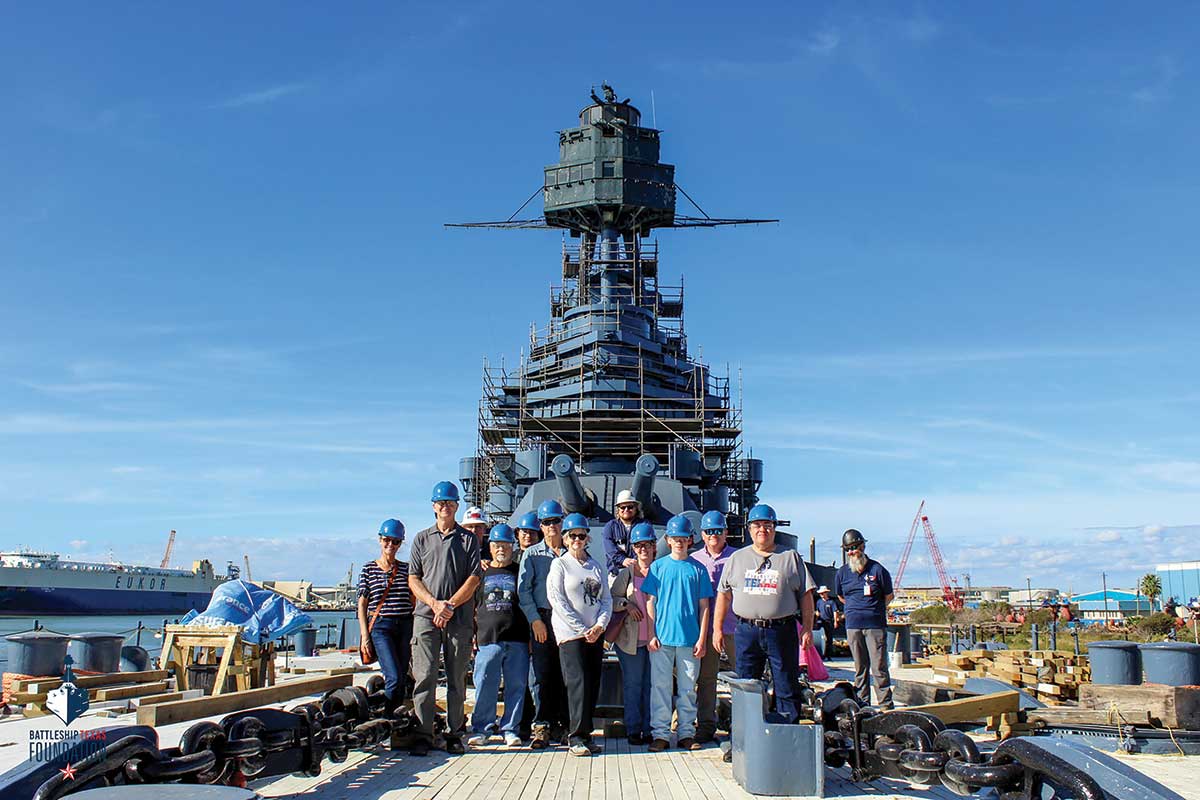As we walk the gangway on a Sunday tour, we step off the solid ground of the Port of Galveston onto one of the world’s most notable naval military vessels, the USS Texas.
Above our heads a 48-star American flag flutters in the stiff coastal breeze. The flag signals the battleship is being restored to its World War II condition, specifically to 1945, before Alaska and Hawaii became states. A freshly painted main mast soars overhead as we make our way across wooden decking still under restoration.
Steel and wood are painted the blues of camouflage Measure 21 to match the Pacific Ocean. During World War II those shades afforded the ship a level of cover that made it hard for Japanese fighter planes to pick it out of the vast ocean.
Our group pauses at the spot where a German shell hit but didn’t explode during the Battle of Cherbourg off the coast of France in 1944. As we pass two 5-inch guns, our guide tells us how sailors used these guns in fierce firing during the critical Pacific battles of Iwo Jima and Okinawa.
As we duck and dodge our way across the battleship, a few in the small group bump their hard hats on protruding pipes and steel structures. We slip into the captain’s cabin, where restoration efforts uncovered a hidden map painted on a steel wall plate, detailing the duty served by the USS Texas during World War II.
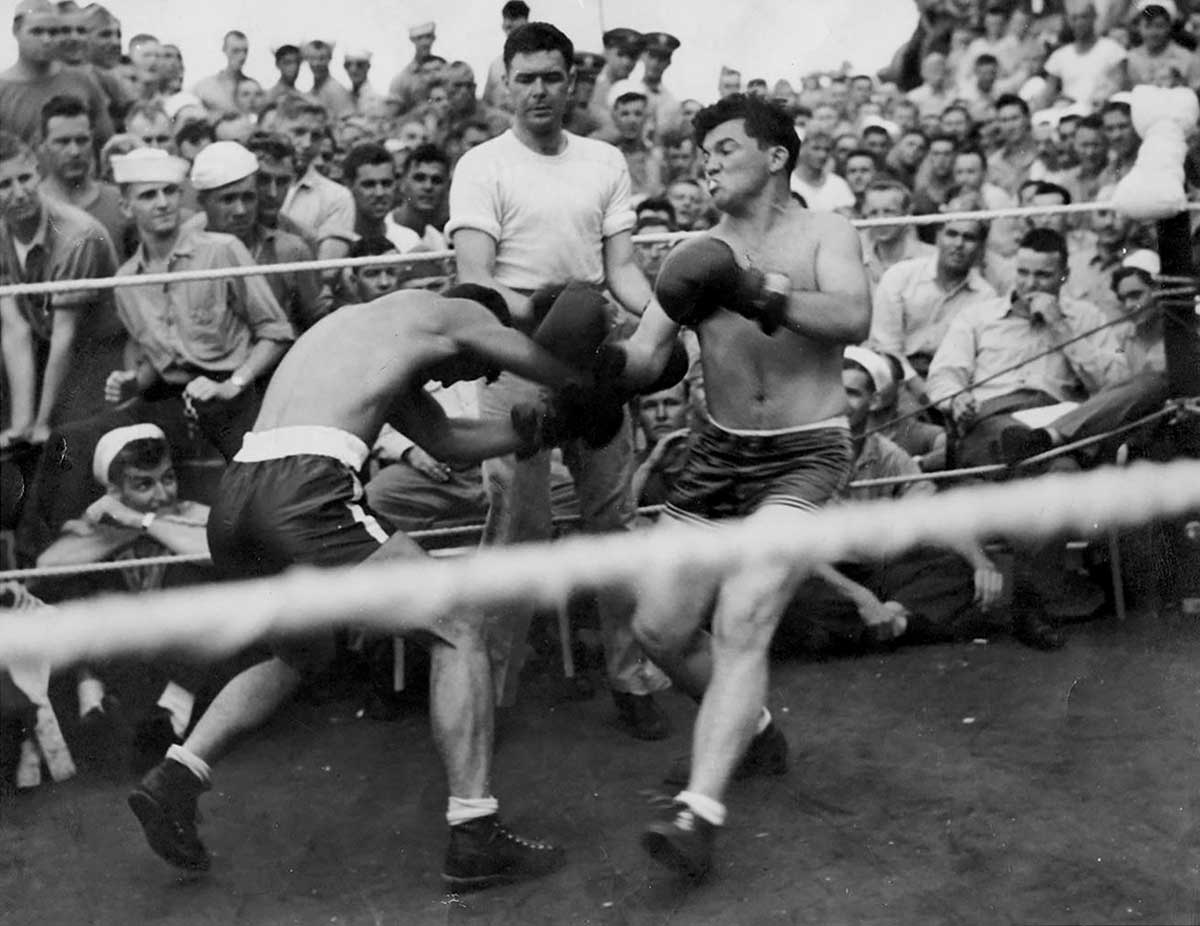
Boxing was one of many sporting activities that boosted sailor morale during long stints at sea.
Courtesy of University of North Texas Libraries Special Collections
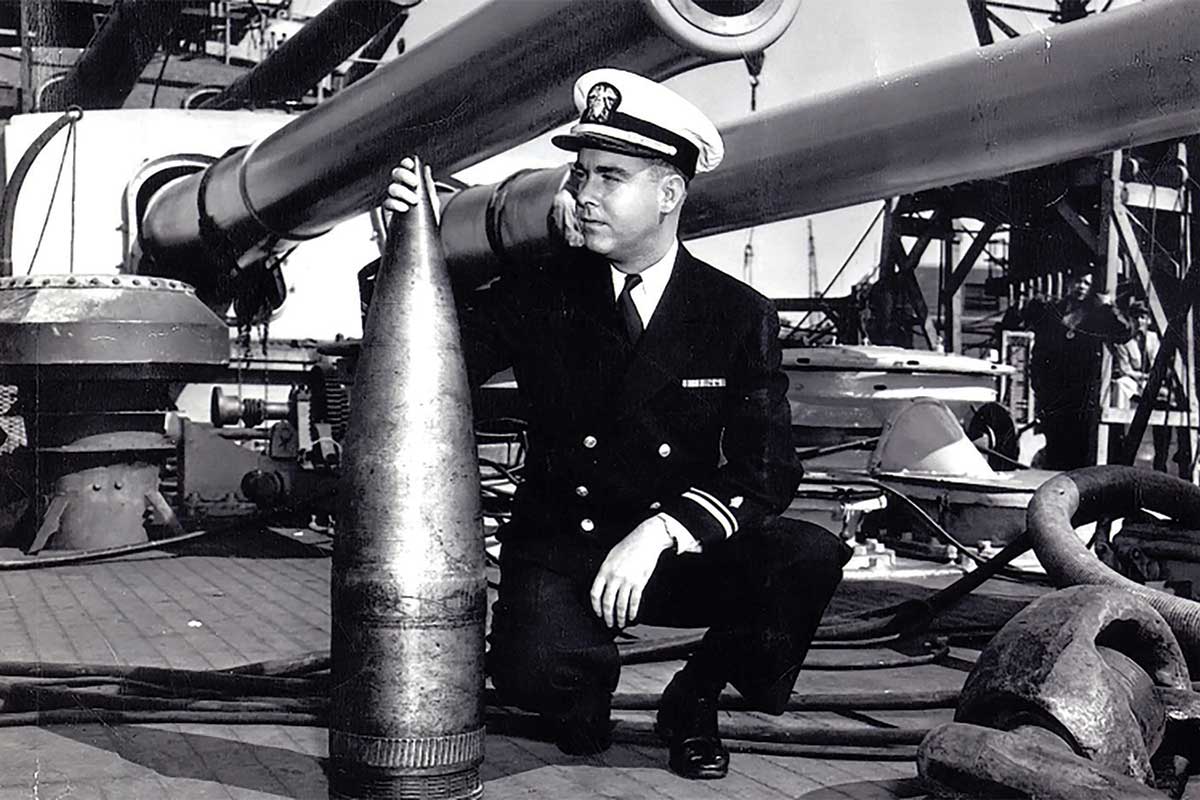
Only two enemy shells hit the USS Texas. One landed as a dud during the Battle of Cherbourg. The shell was defused and remained a ship’s trophy. Pictured is Lt. John J. McArdle in 1944 with the dud shell.
Courtesy of the Battleship Texas Foundation
Visitors can only walk the decks of the 573-foot-long dreadnought, commonly called Battleship Texas, on Sundays because the rest of the week it’s not only a floating battleship museum—America’s first—it’s also a floating worksite at Galveston’s sprawling Gulf Copper Shipyard.
If all goes well, Battleship Texas may be towed to its permanent mooring at Pier 15 in the heart of Galveston’s downtown tourist district as early as later this year.
“It’s a dream spot for us. It will be far safer and cheaper to keep her there,” explains Tony Gregory, president and CEO of the Battleship Texas Foundation. “When we open to the general public with exhibits onboard, we expect to draw around 250,000 visitors each year, providing enough revenue to keep her financially stable.”
The Texas Parks & Wildlife Department owns the ship and worked with the state Legislature to fund $60 million in restoration. A private capital campaign is ongoing for further restoration funds.
World War II ended in 1945, and the USS Texas, like many other battleships, appeared bound for the scrap heap. The first-of-its-kind battleship was offered to the state of Texas, and in 1948, the decommissioned ship was moored near the grounds of the San Jacinto Museum, some 40 miles north of Galveston. There it attracted up to 80,000 visitors annually but simply didn’t earn enough revenue to maintain the vessel.
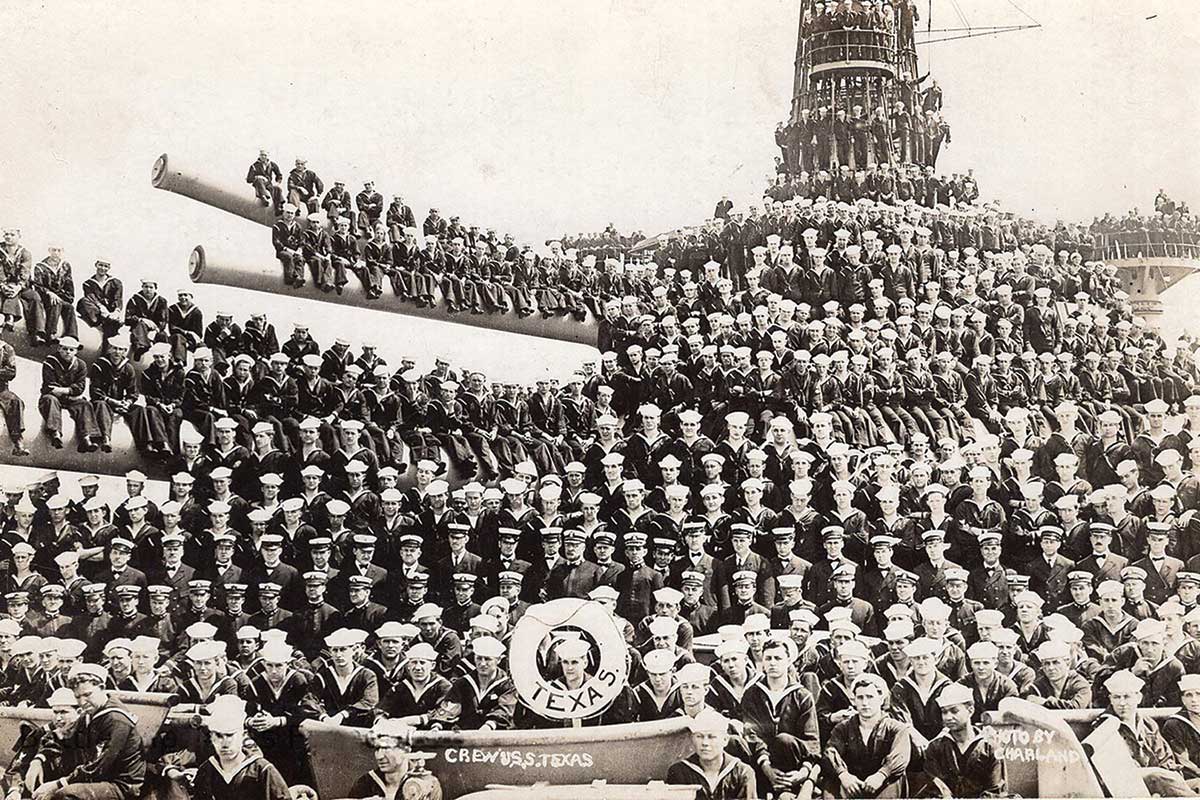
During World War II, the battleship carried more than 1,800 sailors.
Courtesy the Battleship Texas Foundation
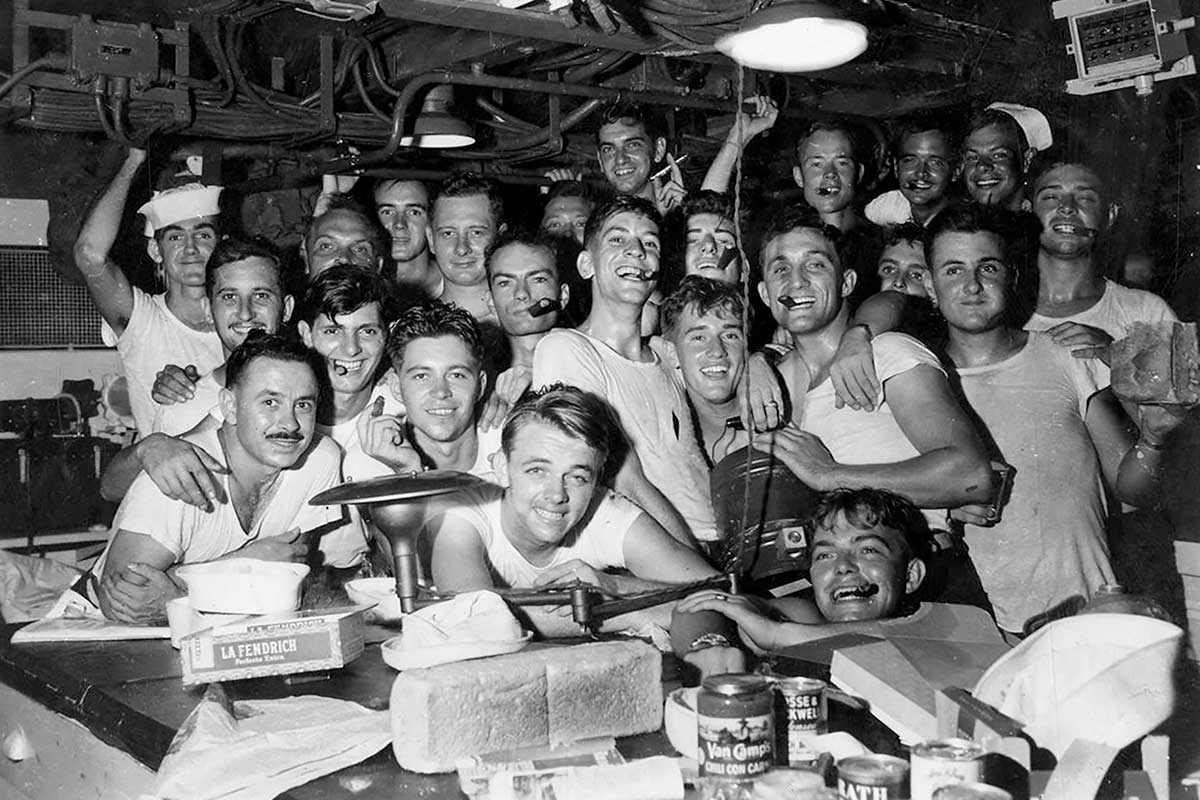
Sailors aboard the Battleship Texas celebrate V-J Day and the ending of World War II.
Courtesy of University of North Texas Libraries Special Collections
The battleship closed to the public in 2019 and was towed to Galveston as Texans lined the ship channel to watch the momentous event. Rusting and leaking, the once-mighty battleship reached Galveston, where restoration efforts stabilized the vessel, allowing the ship to float proudly as it did during a vaunted 34-year naval career.
“My son’s fourth grade elementary school class was to tour the Texas before it closed, but an explosion in Deer Park prevented his class from going,” said Chad Simon, communications specialist at Sam Houston EC. “He will be a sophomore in high school next year. We are excited to take him so he can finally get the tour.”
Legacy at Sea
When it was commissioned, in 1914, the USS Texas was considered the most powerful weapon in the world. Today it’s the last remaining dreadnought and the only battleship left that served in both world wars. As part of the intimidating Grand Fleet during World War I, Battleship Texas witnessed the surrender of the German fleet in 1918, the single largest naval victory with no shots fired.
During its distinguished and lengthy career, the battleship also played a major role in advancing naval warfare technology. In the spring of 1919, American naval aviation began with the takeoff of a Sopwith Camel biplane from a ramp built atop one of the USS Texas’ turrets. In the years before World War II, the ship received experimental equipment that led to the development of air search radar.
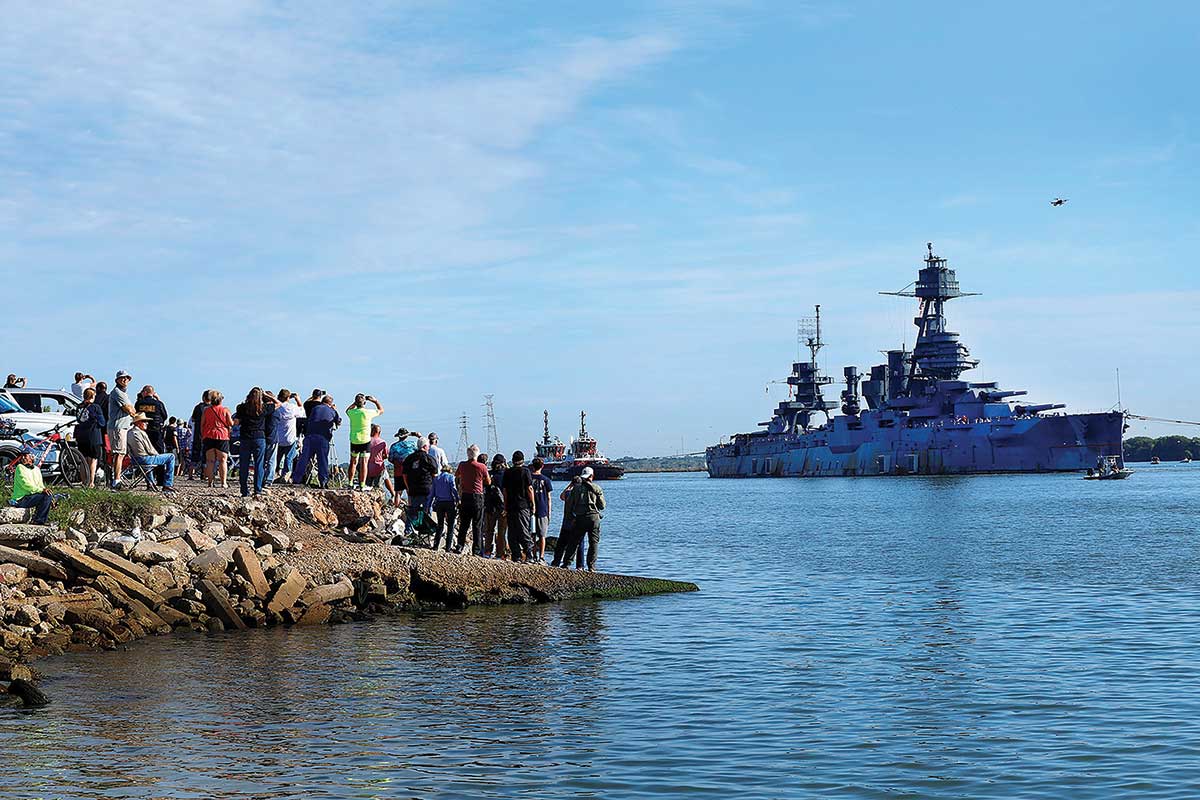
Crowds watched the Battleship Texas being towed through the Houston Ship Channel on its way to dry dock and restoration at the Port of Galveston.
Courtesy of Sam Houston EC
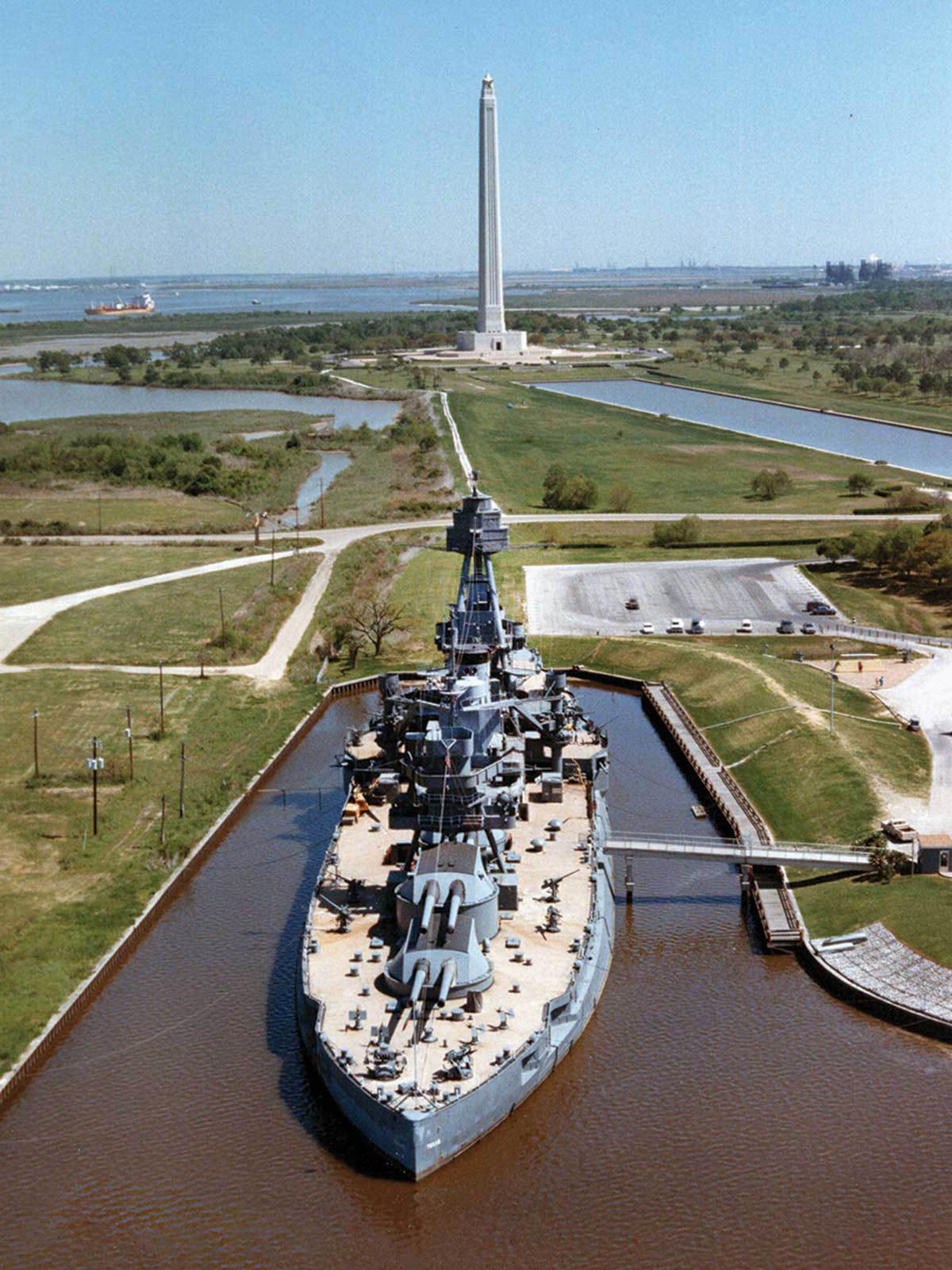
The battleship berthed for decades near the San Jacinto Monument, the world’s tallest war memorial.
Courtesy of the Battleship Texas Foundation
In 1927 it became the flagship for the commander in chief of the U.S. and the U.S. Fleet. But the battleship’s claim to fame derives mainly from action in every major amphibious landing of World War II, the only Allied battleship to do so. It served in North Africa, Normandy, southern France, Iwo Jima and Okinawa, earning five battle stars and losing only one crew member to enemy fire.
The USS Texas is the last intact battleship that participated in the invasion of Normandy. A Sunday tour focuses on those tense days off the French coast. Most of the battleship’s crew of 1,800 handled munitions. At one point, the ship’s large guns fired 255 of its 14-inch shells during a 34-minute period, averaging 7.5 shells per minute, its longest sustained firing of the war.
During the Battle of Okinawa in 1945, Capt. Charles Baker even employed an old naval technique by listing the ship to one side, angling the large 14-inch guns higher in order to target enemy positions outside normal range. Fighting was so intense, the captain ordered the crew to stay at battle stations, eating and sleeping at the ready, for 50 straight days, setting off nearly 6,000 rounds of antiaircraft ammunition in the process.
Earlier that year, sailors aboard Battleship Texas also observed the famous flag-raising at Iwo Jima.

The battleship will be permanently anchored near the Port of Galveston cruise terminals.
Courtesy of the Battleship Texas Foundation
Saving the USS Texas
The battle to save the USS Texas lasted twice as long as the ship’s service at sea.
After World War II, old battleships were no longer needed. Battleship Texas’ sister ship, the USS New York, was used for target practice and sunk by the Navy. Battleship Texas awaited the same fate until a group of political and civic leaders in Houston and statewide sprang into action, said Gregory, whose grandfather and mother both joined the massive effort.
This group of power brokers saw the San Jacinto battlefield—where Texas forces defeated Mexican forces during the Texas Revolution in 1836—as a fitting option.
“These people harnessed the state’s post-war sense of pride and the historical importance surrounding the battleship to save it,” Gregory said.
The effort got a boost in the late 1980s when the ship was towed for the first time to Galveston for critical repairs to extend its life expectancy. By 2022 the ship desperately required more maintenance, so state and private donations brought it back to Galveston for restoration and to look for a permanent home.
“Many of us were unhappy for a long time with the ship’s state of disrepair. The state of Texas needed to step up, and it did,” Gregory said. “Now, through teaching the story of the Battleship Texas, we can instill a greater sense of pride in Texas and in the U.S. Navy. The more people who visit the Texas, the more secure her future will be.”
Battleship Texas is located at Gulf Copper Shipyard in Galveston, 2920 Todd Road. For history, educational and outreach programs, tours and events, and to donate to the project, visit battleshiptexas.org. Sunday tours can be scheduled through the end of June. For updates check the Facebook page for the Battleship Texas Foundation.
